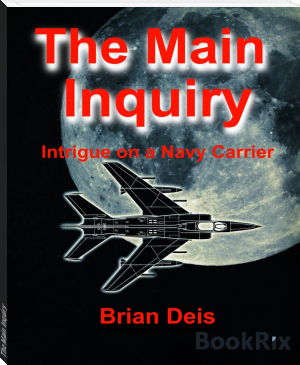The Main Inquiry, Brian Deis [ebook reader that looks like a book txt] 📗

- Author: Brian Deis
Book online «The Main Inquiry, Brian Deis [ebook reader that looks like a book txt] 📗». Author Brian Deis
“Hi, Bentley,” I said as I approached him. I was trying not to get into the conversation about President Nixon and the things that “must be done in the first year.” My next year included none of the things that Bentley thought were at the center of the universe. I gave him a perfect Navy salute and stated that I was ready to relieve him as air boss.
“Very well,” he said, as he returned the salute. “I’m ready to be relieved. Cutting it sort of close aren’t you, Main?” Everyone in the air group had a call sign used on the radio. Mine was Panther, because I got a little aggressive at times. The call sign was assigned by the other pilots, and I had no input at all. When not on the radio, everyone was called by their last name. The Navy is just full of odd traditions and this is one of the oldest.
I explained that the chief had several problems that he wanted me to solve before I “went up to play with them college boys.”
Bentley responded, saying, “Yeah, he is a pain in the ass sometimes, but you are lucky to have him. I think he is the best crew chief in the Navy.” With that, Bentley launched into the checklist of things that had to be discussed before turning the watch over to me. This process took about 30 minutes and covered the status of the ship, as well as the readiness of the wing to fly the mission.
In just a few minutes, a second salute delivered the responsibility of the flight ops to me. There was one officer on the bridge representing the wing whenever flight ops were scheduled. My job was to be sure all the things regarding the planes and pilots were done with precision and the highest level of safety. The air boss job rotated among all the senior pilots in the wing. That meant that several times a month, I would get to spend parts of 24 hours on the bridge defending the wing. I was responsible for the people, planes and the mission of the day. This was a day that I did not get to fly and did not get to rest for the next day’s busy schedule of at least three flights. I had to be alert to all the details of flying. Most of the pilots hated the day they had to be air boss. I was one of the few who liked the job and was completely at ease on the bridge. I was the exception, due to some prior practice.
The ship was increasing speed to prepare for launch of the 12 planes needed to do the first mission of the night. I was running my check sheet for preparations to launch when the communications tech handed me a phone and said, “It’s your chief, Sir. He wants a piece of you right now!”
I thanked him for the warning and used my best happy tone to say hello and ask what I could do to make his day perfect.
“You know I hate that happy shit you have, Sir,” said the chief in a tone that would remove paint from the bulkhead. “I want to know what you’re going to do about all these useless goddamn planes that are all over my hangar bay!”
I answered by saying that I had a great idea that we might just fly the things like we stole them. “Go ahead with that officer bullshit, and when you’re done, how about telling me what part of your body you would like me to shove these planes in?”
“Oh chief,” I said, “it’s always good to talk to you. So how about you tell me what the hell you want me to do?” He explained that the orders were to keep the planes on the hangar deck and to feed the planes up the elevator one at a time. The hangar deck was one level below the massive flight deck that served as the runway for the planes. I knew that came from Bentley, because he loved the flight deck to look neat and well-organized.
The problem was that we would be launching the planes in very fast order, so that we could turn out of the wind and slow back down as soon as possible. It is very dangerous to have the monster ship going fast and the wind over the deck at nearly 100 mh. If we lined up all the planes on the upper deck at the same time, we could launch faster. Having the planes up on the flight deck would let us pre-check the planes on the deck with the motors running. Since this was the first mission of the night, there were no planes coming back. The chief was wondering why we were not following the standard practice of moving all the planes to the flight deck level before we started to launch.
“I got it,” I said. “You’re having problems figuring out how to move my planes so that we can do our jobs. That’s OK, Chief, I’ll set it up so that you’ll have an easy day of it. Send the planes up ASAP after final checks and we’ll line them up on the main deck. If there is anything else the air boss can do, just call on me.” He replied instantly, “I can think of several things I would like to tell you to do, Sir, but I am busy saving democracy as we know it. I will make up a list and have it translated into pilot talk so that you can understand what I mean.”
“No problem, chief, I always know what you mean,” I said with a laugh.
The chief and I worked together every day and our banter was all that kept us from fighting with each other. His job required that he ask me for things that I usually couldn’t do when he needed them to happen. We had worked out most of the issues and the good humor remained. Bentley was quite right; the chief was the best at what he was assigned to do.
I would have to find time for another talk with Bentley about the standard procedure of having all the planes on the upper level (flight deck) before we set up to run air operations. There were elevators that moved planes between the upper flight deck and the hangar bay one level below the flight deck. During flight operations, it was preferred not to run the elevators. It was the standard process to get all the planes that were to be launched on the flight deck before any flight operations were begun. As the planes landed, they were parked on the flight deck for movement after flight ops were over. There was ample room designed into the flight deck to accomplish all of the goals.
I turned my attention to the flight status of the ship. The planes we would fly that day had a minimum flight speed that had to be attained during launch or the plane would get real wet right in front of the ship. The launch included three different types of planes. We had only 5 knots of wind that day, so there was not a lot of help getting over 140 knots to fly. The catapult’s speed was adjustable and the ship had to make up the difference between the speed of the wind, catapult, and the minimum speed of the plane. This requirement was why the biggest ships in the Navy were also the fastest.
We could launch planes, on a calm day, with a punishing catapult setting and lots of steam in the four power plants. The carrier traveled with a formation of ships that supported the mission and protected the carrier. None of the support ships could begin to match the speed of the carrier on a calm day. The ship took off and left the support ships like they were standing still. After the planes were launched, the ship would slow and allow the others to catch back up. This was the normal set-up when the ship was doing flight operations.
I adjusted the course and speed to get the wind right down the launch deck and cranked up as high as I could for the 12 Phantoms. They were the fighters of the day and possessed the speed and weapons to support the action going on in-country. They could do many different missions to support the fighting and it was that versatility that made them the best choice for that part of the conflict. Our planes were reliable, with enough power to carry the full load of weapons if need be. The pilot’s primary requirement for fighters would always be the reliability to get us back to the ship. Except for some armor problems in the belly of the plane, and the lack of a cannon in the nose, we liked the plane. I found comfort in the knowledge that when in a tight spot during a mission, I was sitting in the fastest plane in history and the holder of the world speed record. At a max speed of 2.2 times the speed of sound, I could dive to the trees and stand on the afterburners. I would let the big jets in the plane pull me out of trouble at the astonishing speed of over 1,400 miles per hour. It was not fancy. It was also not like the dog fights I grew up watching in the movies and reading about in books, but it worked for us.
The first plane of the 12 to be launched was pushed into position on the right-hand catapult of the forward deck. It was hooked up and final-checked for launch. The deck leader plugged into the communication system of the plane to run checks with the back seat. The RIO was the second man in the plane and, as radar intercept officer, he navigated and operated the weapon systems of the plane. The pilot was in the front and concentrated on flying the complicated state-of-the-art plane. This division of work was required as one man could not do all the tasks required in combat. The back seat did not have flight controls, and that made the RIO a nervous passenger when the situation got challenging.
The deck crew confirmed that the plane was all set to launch and reported to me. I keyed the radio and said “Joker - Overloard you are clear to launch, good luck” and I heard the response “Overloard - Joker roger launch.”
The pilot got confirmation from the back seat that all was ready to fly and delivered a salute to the catapult operator that said they were ready. This is all routine for the members of the wing, and, with all actions taken and the calculations made, the operator fired the mighty catapult that accelerated the plane to the edge of the deck and released it fly. The afterburners helped the plane climb and the Joker





Comments (0)